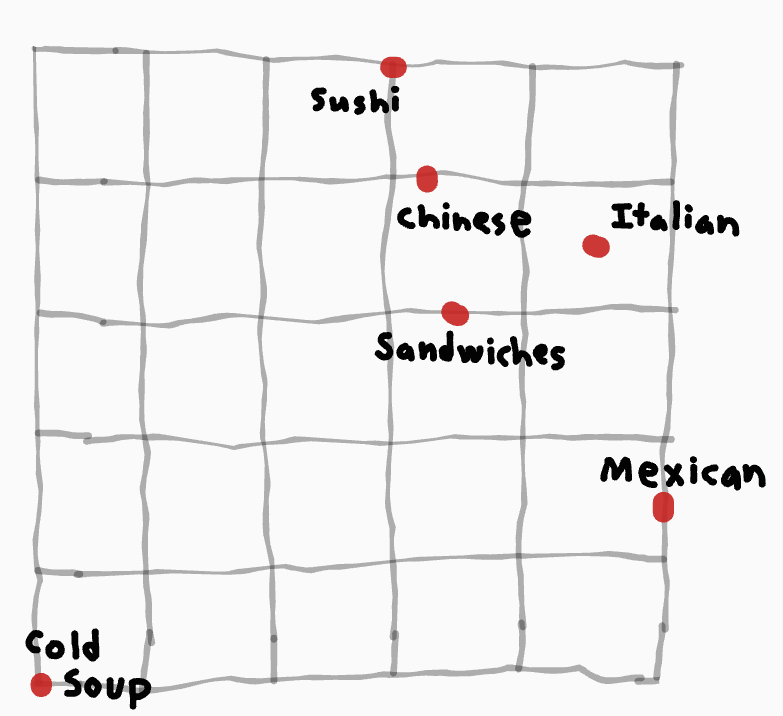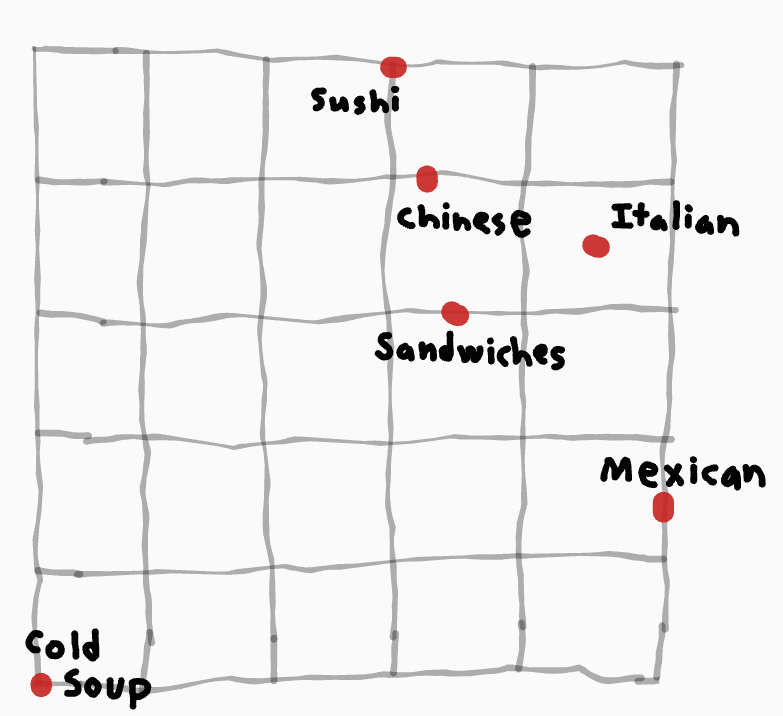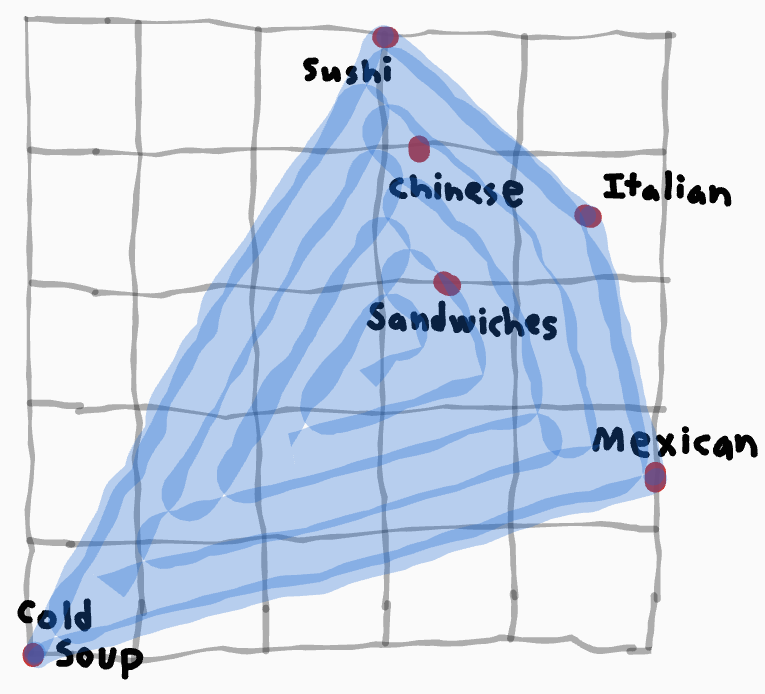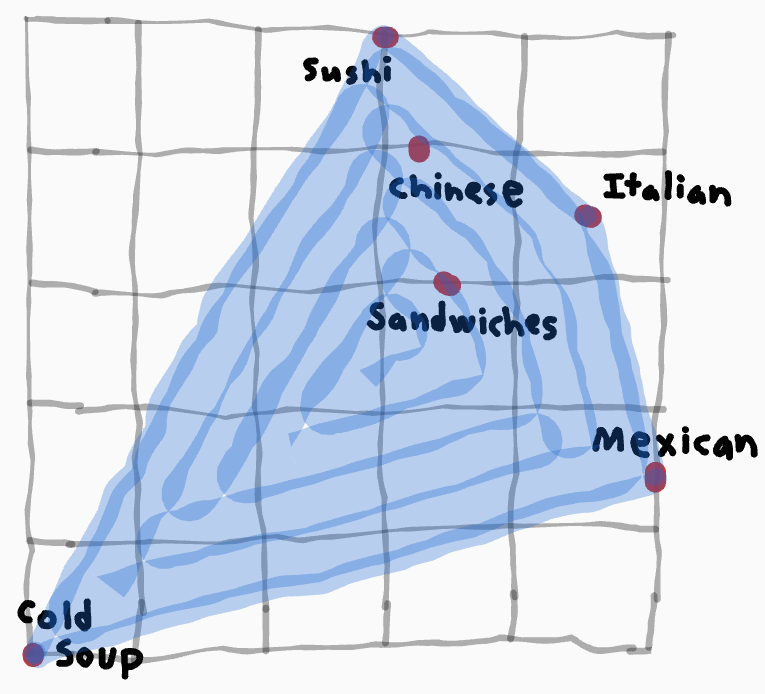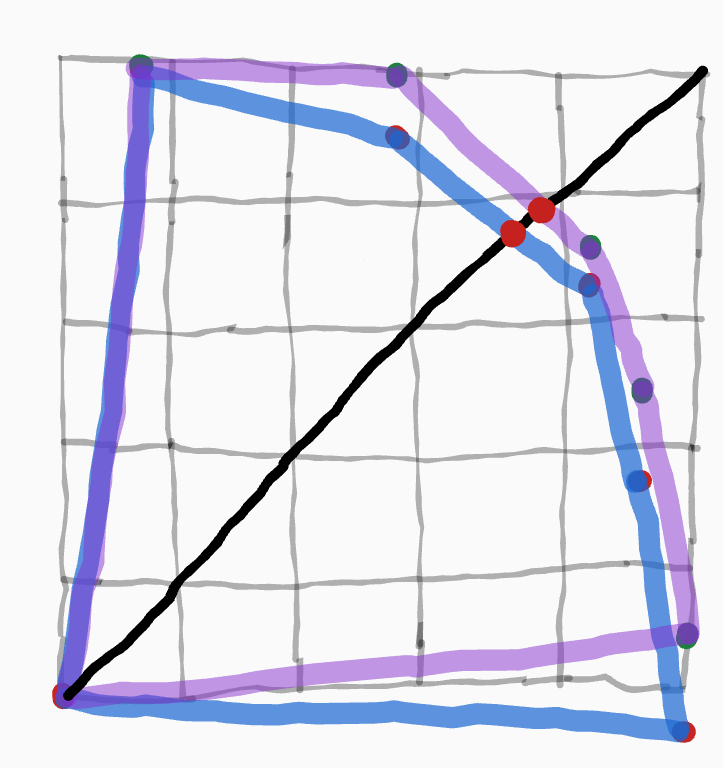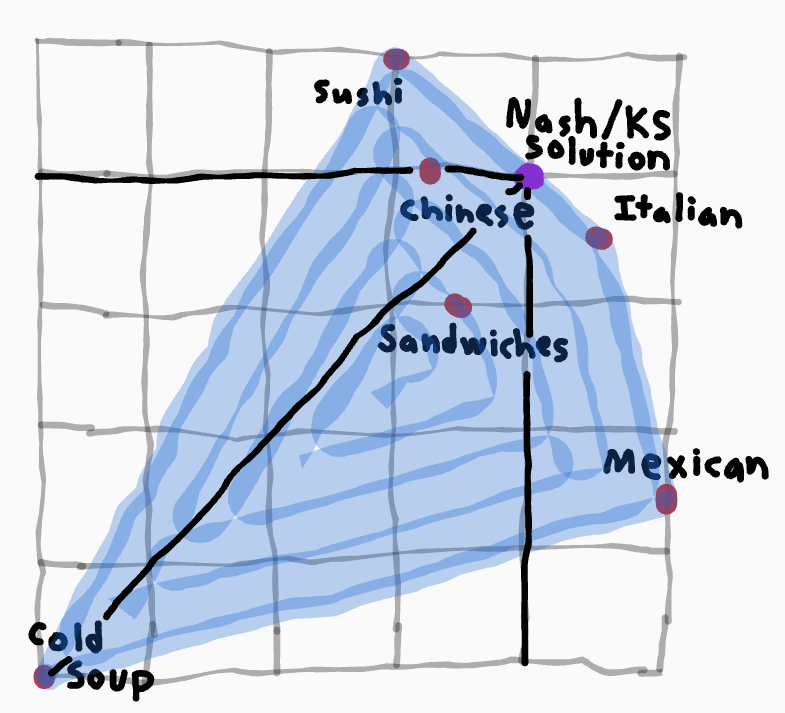Unifying Bargaining Notions (1/2)
11MSRayne
1Alex Vermillion
1Dweomite
2Quantum Tesseract
0Dweomite
1Alex Vermillion
1Dweomite
1Alex Vermillion
1Quantum Tesseract
0Dweomite
1Quantum Tesseract
1Dweomite
1MSRayne
10mako yass
10Richard_Ngo
2Nathaniel
9MondSemmel
7Ruby
7Angela Pretorius
4the gears to ascension
4the gears to ascension
3artifex
3Dagon
14Diffractor
9SarahNibs
3Dagon
4SarahNibs
4SarahNibs
2MondSemmel
2Diffractor
2johnswentworth
6Diffractor
2Andrew_Critch
1lexing
2Diffractor
1philip_b
2Diffractor
0IrenicTruth
3Dweomite
0IrenicTruth
5Dweomite
New Comment
This is fantastic and I am definitely looking forward to the next post.
Something I've often wondered about though is that the definition of fairness (though not necessarily of chaa!) seems strongly dependent on who, exactly, is taken into account as being a player of the game, which to me seems quite arbitrary. This concern isn't about the math or reasoning of the post, so much as my lack of clarity about how exactly it ought to be applied in real life.
Example: a factory owner is bargaining with his employees over pay. He points out that since he provides the capital needed for the factory to run in the first place, he has a significantly higher Shapley value than any individual worker, and deserves more wages. But an employee counters this by reminding him of all the people who built the factory, and the people who did the scientific research for how to design the machines, and the truckers who moved items to the construction site when the factory was being built - and even the employer's parents, whose wealth he inherited and used to fund building the factory in the first place. If you include all of those people as part of the "game" of the company, since their contributions were also partly responsible for its success and for any profits it makes, suddenly the Shapley value of the owner seems much smaller.
The same thing goes for other situations. Even games with a competitive element often have players (people affected by, and able to affect, the outcome) who are not obvious on the surface. Wars are games between not only national governments, but also corporations and wealthy elites who have a stake in the outcome - and large enough groups of concerned citizens, at least in democracies, can also affect what happens and force their values to be taken into account. So, in situations like that - situations where it's not clear exactly who the players even are - how can one find the fair outcome?
Actually, I just checked this, if you split the factory owner into multiple agents, the workers capture less and less of the value.
What model are you using to conclude the workers capture less value?
I'm reasonably sure Shapley values are preserved under agent decomposition. That is, if you split agent A into multiple agents B+C who collectively make the same contribution as A, their combined share should be the same as A's original share. EDIT (a long time after the original comment): I no longer believe this.
Though I don't know whether/how you can extend this model to handle the fact that players can join and leave the "game"--workers can quit, other workers can be hired, the owner could decide not to build the factory but a different tycoon could build one instead, etc. This means you aren't dealing with a fixed pool of "players". (One theoretical option is to treat the entire world as one giant game, but then the problem becomes intractable.)
It becomes a lot more obvious when you consider two factors; 1, that every agent wants to maximize its utility, and 2, that no split will be agreed to if it makes one agent worse off for participating in the trade than their bull action. Consider our simplest factory case: a factory that requires 1 owner to supply capital and one worker to provide labor. Since both are required to obtain the output, you split the gains from trade by taking the income from the factory, paying out the costs to bring both agents to net 0 from agreeing to the trade (ie, maintenance on the capital, taxes, insurance against work injuries, food to replace calories expended in labor, etc). Then whatever is left, the profit, gets split between both.
Now expand this. If there is one supplier of Capital and 2 workers, but it still only needs 1 worker to function, how does the split go? If the workers have good decision theory, they realize their best option is to coordinate. The Capital provider and the Laborer each get 50-50 split, and since each laborer has a 50% chance to be chosen that comes out to 50-25-25. This comes from a few factors. First, the Capital owner won’t accept less than half. If he is better off refusing to deal with B entirely and just trade with A, obviously he will do that, so our split has to be at least 50 to him. However, the workers also won’t accept less than 25 in expectation, or else they are both better off with one of them going to the other and saying “I won’t compete with you in exchange for half your profit.” A 50% chance at a 70-30 split (since there is a half chance each is chosen) is worse than that in expectation, even if the nominal payout is higher. Thus if the owner won’t accept less than half and our workers won’t accept less than a quarter, the only possible split is 50-25-25. Since our position is symmetric, 2 Capital providers and one laborer get a 25-25-50 split. Assuming there are 2 of each, that comes down to 2 50-50 splits again, since any lesser split has a better alternative that one party can force. Thus in any trade that requires one member of party A to contribute and one of Party B, each member of party A gets 1/2*#A and each member of B gets 1/2*#B. If the factory requires 2 workers to function, you can treat those two workers as a single agent that distributes half of the profit between them.
This has a few desirable outcomes.
- For one, you are never better off for having more competition
- You are never worse off for having more people to trade with
- There is no coordination between agents that can reduce this to a simpler form that gets in expectation a higher payout for that group
- it is agnostic of which of a set of interchangeable options is chosen.
- There is no incentive to create dummy agents
And most importantly,
- it is very simple to calculate. However many workers there are split between them half of the profit, irrespective of how large the labor pool is. This gets them in expectation less money since they have less chance of getting picked, but doesn’t change the amount changing hands in each actual timeline.
First, I note that this comment thread was previously about Shapley values, and you don't seem to have done any Shapley calculations. If this is meant to be the same rule, but explained from a different angle, then I don't see how to establish equivalence. If this is meant to be a new system, then I don't see how it generalizes to more complex examples, such as where the factory output scales with the number of workers (rather than being all-or-nothing). (I also don't see why you'd choose this particular comment to start promoting your alternative system.)
Second, you're analyzing a situation where a required input can be provided by any of multiple parties; that is, if there are 2 owners, you only need 1 owner to agree in order to make the factory run. But the story problem above was about a situation where you need all of multiple parties; i.e. replace the 1 owner with 1 capitalist + 1 technologist and you need both of them to make the factory run.
If I came to you and said, here's a game with 3 people (1 worker + 1 capitalist + 1 technologist), you need all 3 people working together to produce anything, how do they split the profits? I suspect you'd say an even 3-way split. But that implies that the owner from the 2-person can divide himself into 2 dummy agents (1 capitalist + 1 technologist) and then demand 2/3 of the profit (up from 1/2) because he's now (nominally) doing 2 out of 3 jobs.
How do you prevent this exploit?
Third, I don't buy your claim in your advanced examples that "any lesser split has a better alternative that one party can force". For instance, in the 1 owner + 2 workers example, if the owner offers worker A a 70-30 split, that's better for both the owner and worker A than your proposed split, and I don't see what worker B can do about it.
You seem to be arguing that worker A should reject this split on some sort of timeless logic (?) where A reasons that there was an equal chance the offer would have been made to B and so if A+B are the sort of people who accept this offer then they each get 15 in expectation across all counterfactuals. Even if you buy the timeless logic, this only works if A and B use correlated strategies such that A is effectively choosing for both of them; otherwise, after A rejects this split, the owner proposes it to B and A gets nothing in all counterfactuals. So that seems to me like a coordinated solution, not a solution that a single party can unilaterally force.
In fact, it looks to me like you've said something pretty close to "my system rewards monopolies, so A and B are incentivized to form a cartel and act like a single agent, and therefore I assume they do so."
I did a really simply and naive thing in an online calculator, and I'd like to state explicitly that I'll be quite intrigued if you show me I did it wrong as I feel I must have made a mistake looking back over this comment.
I used http://shapleyvalue.com/ with several (ANNOYING TO INPUT) sets of values (10 utility in each).
Here I did a trivial thing where you need all owners and 2 workers here, and included only those people. You can see that they trivially are going to telescope to each getting 1/n of the value out.
1 owner / 2 worker = ( 3.33333 / owner, 3.33333 / worker) 2 owner / 2 worker = ( 2.5 / owner, 2.5 / worker) 3 owner / 2 worker = ( 2 / owner, 2 / worker)
Apologies for the bad example, but I really don't want to enter all those cells again and am going to only do the better computations if I write some code for it later.
Sounds like you set up a model where the factory produces nothing unless it has 100% participation from all players, which means that all players are in equivalent positions (any one of them can veto the entire operation and leave the other players with nothing). Under this model, "owners" and "workers" are actually equivalent--you've assumed that if 1 worker goes on strike, the entire factory shuts down.
Obviously, if all players are in equivalent positions, then by symmetry they'll have equal payouts.
In the original story-example, the factory owner can claim a higher Shapley value on the basis that if you removed just 1 worker, the factory would still produce quite a bit, but if you removed the owner, you wouldn't have a factory anymore.
A very simple model for this might be something like: owner + any N workers produces N utility, while any subset not including the owner produces 0 utility. Then, with 10 workers + 1 owner, if you add people in a random order, each worker produces an average of 0.5 marginal utils (= 0 if added before the owner, 1 if added after) while the owner produces an average of 5 marginal utils (= the average number of workers added before the owner).
If you double the number of workers to 20 (and thus double the max output to 20 as well), then each worker still adds an average of 0.5 marginal utils, but the owner now adds an average of 10 marginal utils. So the worker wages stay the same, but the owner earns more from the larger operation.
Now suppose we go back to 10 workers, but now we have 2 owners, with the rule that the factory produces 0 unless both owners participate. (Thus, these 2 owners collectively do the same job that the 1 owner previously did.)
A worker produces 1 marginal value if added after both owners, 0 otherwise. Since there are 2 owners, on average 1/3 will be added before both, 1/3 between, and 1/3 after both. So the worker average is 1/3 util.
The first owner added produces 0, the second produces as many as there are workers. On average 2/3 of workers are added before the second owner, so the second owner produces 6.67 marginal utils. Each owner is the second owner half the time, so each gets 3.33.
...um. That is not the result I was expecting.
Can anyone either point out an error in my math, or explain to me philosophically why I ought to be ok with this result? It seems concerning to me if the factory gets a different share depending on whether it's owned by 1 person or by 2 people.
Yup, I wrote the program and still get owner-value-portion-grabbing. If it's any help, I can now generate any simple pattern you want very quickly and easily.
Only the second owner to join adds any value, so they get the same slice as the sole owner in the first example, ie, half. Since each owner has a 50% chance of being the second owner, they each get 25%. With 3 owners it’s 1/3*.5=1/6. Etc. the math works out very neatly this way.
Only the second owner to join adds any value, so they get the same slice as the sole owner in the first example, ie, half.
Show your work and/or explain what's wrong with my reasoning above? I already took that into account, but got a different answer, because there's more permutations where the second owner is added late in the sequence than where the second owner is added early in the sequence.
(Note that if my reasoning from the previous comment is wrong, it has to be wrong about both the owners and the workers, since they need to sum to the correct total.)
You’re right, this was less clear than I intended it to be; my apologies. The proposal I offer here is that since the first owner to join offers nothing, they aren’t included in the calculation; you just run them as though the second owner was the only owner, and get the same result for the value of the second owner as you did for the sole owner the first time. This has the advantage of being very computationally simple and gets you the same results as the full calculation for this case. It’s a specific case of a broader way you can simplify shapely calculations, where when the payout can be calculated by (A1+A2+A3…AN)*(B1+B2+B3…BM)+…+(X1+X2+…XO), you’ll get the same values for combining “Like Terms” (Not exactly the same concept but I don’t remember what the real word was, been a while) and running the shapely calculation for A, B,…X and then dividing the total of A by which fraction of A each A1, A2, etc terms makes up. For more complicated payout amounts it’s a bit more annoying to do this way but you can still do it if you’re careful to set it up properly. This applies even when one of the terms, eg A2, is 0, which then gets us our specific case here. I don’t remember the exact setup for the proof my professor used, but I don’t think it’s neccesary? It feels like one of those things where it’s obvious once you run it through both ways for an example, but if it isn’t lmk and I’ll see about digging through my old notes.
If I understand you, you're saying that this simplified calculation should give the same answer as the full calculation, and that this should be obvious to me after I try it both ways.
But you're also saying that the simplified calculation is equivalent to the earlier problem with only 1 owner, which means I already worked it both ways (one way in the 1-owner problem and the other way in the 2-owner problem) and I got different answers. So, no, the equivalence is not obvious after running it both ways.
My suspicion is that this half-remembered theorem you are trying to apply actually applies to a different situation and you are using it wrong. But if you don't think that's the case, then yes, I'd like to see a more precise explanation. (And ideally, an explanation of what you think I did wrong in my own calcs.)
That would happen too, yes. But that's the thing. How can one say whether this is good or bad - how fair or unfair this state of affairs is?
A transferrable utility game is one where there's a single resource (like dollars) where everyone's utility is linear in that resource
For humans, money does not seem to have linear returns of utility. For what real agents could it?
My expectation for the U of an aligned AGI would be something like, the sum of the desires of humans, which, if the constituent terms have diminishing returns on resources, will also be diminishing. I can see arguments that many probable unaligned AGI might get linear returns on resources... but if humanity is involved in the negotiation (and you really hope we are) then doesn't that still break shapley? I guess you could still potentially use shapley for analyzing the valence of ecosystems of unaligned AGI, which would be useful for comparing risk of unaligned singletons to unaligned multipolar outcomes and to authoritarian lockin, but it's not exciting, and... actually, everything collapses to aligned-somehwhataligned-unaligned multipolar under the Grabby Aliens model.
There does seem to be a value within the human utility function that does scale linearly with resources (a variable that population ethicists and early longtermists love), but it's not clear at all what its relationship with other variables is. Another way of phrasing this objection is, there is a lot of personal low-hanging fruit that a human has to grab before the scalable variable will be all they have left to optimize, and I don't think I've ever heard of a person who gathered "enough" of the low-hanging fruit of the good life, that they started acting in a purely longtermist or stewardly way. EG, Elon will still want his space adventure no matter how many of his friends explain why they think it's not cost-effective for reducing existential risk. Many people tell this story where, once a person is rich enough and "has their needs met", they're supposed to optimize the scalable term and consequently become selfless (the self is finite, even in the extremes, due to the light speed limit, so anything that keeps scaling has to be a kind of selflessness), many people would like that to be true. It's not obviously actually true, it doesn't accord with present human behavior, and I'm not sure how to investigate it.
Great post. Two comments:
That can be folded into the utility function, however. Just make the ratings of the deferential person mostly copy the ratings of their partner.
Can you say more specifically how this is done?
the axiom of Independence of Irrelevant Alternatives....is not really a desiderata at all, it's actually an extremely baffling property.
The reason it's a desideratum is because it makes bargaining more robust to variation in how the game is defined. I agree it's counterintuitive within the context of a given game though. So maybe the best approach is to take it out, but then specify that we should think of games as being defined via some unbiased meta-bargaining-process...
That can be folded into the utility function, however. Just make the ratings of the deferential person mostly copy the ratings of their partner.
Presumably the deferential parter could just use a utility function which is a weighted combination of their partner's and their own (selfish) one. For instance, the deferential partner could use a utility function like , where is the utility function of the partner and is the utility function of the deferential person accounting only for their weak personal preferences and not their altruism.
Obviously the weights could depend on the level of altruism, the strength of the partner's preferences, whether they are reporting their true preferences or the preferences such that the outcome will be what they want, etc. But this type of deferential preference can still be described by a utility function.
Loved this post, thanks for writing it.
I believe I've found some typos, but given the mathematical nature of this post, I'm less sure about this than usual. Anyway, here goes:
The best move in the cooperation game is Bob going to the airport, and Alice going to the beach, so that's what's played in real-life. The utility from the cooperation game is added to the maximin utility from the competition game (where beach/beach is played), for 100 Bob utility and 150 Alice utility. And so, the solution is that Alice goes to the beach and pays Bob 50 bucks to go to the airport.
Like, if the surplus-maximizing option is one that player 1 values at +80 dollars over the disagreement point, and player 2 values at +40 over the disagreement point, for +120 dollars of surplus value, the CoCo solution is that particular option is picked, and player 1 gives player 2 20 dollars, so both sides walk away with +60 dollars worth of utility.
So if I understand the second example correctly, doesn't that imply that in the first example, Alice should only pay Bob 25 bucks so they both have 125 utility?
Anyways, the value that player i gets is the sum of the values it gets from all of the component games where coalitions compete against each other.
-> the sum of the values they get from
Finally, there's lots of math about set differences. I believe in all these cases, using / as the symbol for a set difference may be wrong (?) or at least unconventional, and should be \ instead.
[These aren't necessarily in order:]
[The first two LaTeX formulas for Shapley values, following the sentence "then the payoff for player i is"]
S⊆N/{i}
the subset N/(S?{i}),
For the game with S vs N/S
in the coalition N/S
[In the two latex formulas after the sentence "producing a restatement of the Shapley value as", plus once after the sentence "But remember, the Shapley value can be re-expressed as"]
v(N/S)
and v(N/S) is the value of the opposing coalition
Curated! I really enjoyed this post (and its follow-up, though I didn't read that one in as much depth) and wholeheartedly endorse continuing the LessWrong tradition of decision-theory posting. The results of the post feel beautiful (I guess that's a common feeling when different notions are unified) and the explanations are lucid.
I won't claim that the post feels immediately practical in my life, though I suspect I will find myself thinking about bargaining strategies and fairness/chaa in future decision theories, and eventually mulling on the ideas here (and seeking out further bargaining knowledge) until it does have implications for my decisions.
More than that though, reading this post felt "healthy". It feels like the kind of seeking of rigor for "everyday" concepts and decisions that you ought to do. I almost feel like this is hunting for the true name of "fairness".
To pull out one piece/attitude I liked:
Accordingly, using the term "fair" for any of these mathematical concepts has the problem of automatically importing human concepts of fairness, which needs to be resisted in order to look clearly at what the math is doing. It'll be handy to have a separate word for "a mathematically distinguished point in a game where both parties have an interest in preventing destructive conflicts, that's neutral enough that aliens would probably come up with it" to enforce that mental separation.
I'd love to see more posts like this, and would also love to see these notions connected to practical applications. Vanessa Kosoy replies in a comment that a reason some of the results might seem ugly is that we're already assuming "morality", i.e. already having a bargaining solution and we're not starting from square 1. So I'd be interested to see bargaining applied to the situations we already find ourselves in.
I wonder how often the CoCo point is attained in real life transferable utility bargaining games.
Eg. Do most houses sell for half way between the seller’s walk away price and the buyer’s walk away price? Do most employees earn a wage that is half way between the employee’s walk away wage and the employer’s walk away wage (at least when the employee’s walk away wage is above the legal minimum wage)?
aha it's a probabilistic blend over assignments of individual-player action tuples that the team S can take, ie the mixed actions of team S
To put it mildly, this is not really a desiderata at all, it's actually an extremely baffling property.
How can we decide an axiom used to pin down a bargaining solution is intuitive or baffling without first having a goal in mind? Which axioms are sound for the bargaining solution used to pick deals depends on the purpose that led us to want to apply bargaining theory to a problem. If you’re designing a file sharing protocol, you don’t care about bargaining chips. You just want the files to be distributed quickly. Or if you’re designing a standard for network equipment and you want to minimize spectrum congestion or wireless interference, knowing that you can’t trust the owners of the equipment not to be selfish at the expense of other users. You want the solution that works best and if some solution that isn’t the solution that works best becomes unavailable, that doesn’t change the solution you consider best. Independence of irrelevant alternatives is sound for some of the goals we want to apply bargaining theory to.
I really wish you'd included the outside-of-game considerations. The example of what to eat for dinner is OVERWHELMINGLY about the future relationship between the diners, not about the result itself. This is true of all real-world bargaining (where you're making commitments and compromises) - you're giving up some immediate value in order to make future interactions way better.
Agreed. The bargaining solution for the entire game can be very different from adding up the bargaining solutions for the subgames. If there's a subgame where Alice cares very much about victory in that subgame (interior decorating choices) and Bob doesn't care much, and another subgame where Bob cares very much about it (food choice) and Alice doesn't care much, then the bargaining solution of the entire relationship game will end up being something like "Alice and Bob get some relative weights on how important their preferences are, and in all the subgames, the weighted sum of their utilities is maximized. Thus, Alice will be given Alice-favoring outcomes in the subgames where she cares the most about winning, and Bob will be given Bob-favoring outcomes in the subgames where he cares the most about winning"
And in particular, since it's a sequential game, Alice can notice if Bob isn't being fair, and enforce the bargaining solution by going "if you're not aiming for something sorta like this, I'll break off the relationship". So, from Bob's point of view, aiming for any outcome that's too Bob-favoring has really low utility since Alice will inevitably catch on. (this is the time-extended version of "give up on achieving any outcome that drives the opponent below their BATNA") Basically, in terms of raw utility, it's still a bargaining game deep down, but once both sides take into account how the other will react, the payoff matrix for the restaurant game (taking the future interactions into account) will look like "it's a really bad idea to aim for an outcome the other party would regard as unfair"
Maybe a side note to not forget outside-of-game considerations? But I'm perfectly fine reading about 4/3 pi r^3 without "don't forget that actually things have densities that are never uniform and probably hard to measure and also gravity differs in different locations and in fact you almost certainly have an ellipsoid or something even more complicated instead", and definitely prefer a world that can present it simply without having to take into account everything in the real world you'd actually have to account for when using the formula in a broader context.
Ok, downvoted for that enough that I should just shut up. But I learn slowly.
These aren't outside considerations. Future interactions (or, I guess, highly-suspicious superrational shared-causality) are the primary driver for any non-Nash outcome. Use of these examples is more misleading than the canonical frictionless uniform spherical elephant, and even for that, every book or professor is VERY clear about the limitations of the simple equation.
I'm a huge fan of the research and exploration of this kind of game theory. But without really understanding the VERY limiting assumptions behind it, it's going to be very misleading.
A better example might be literally paying for something while in a marketplace you're not going to visit again. You don't have much cash, you do have barter items. Barter what you've got, compensate for the difference. Cooperative is "yes a trade is good", competitive is "but where on the possibility list of acceptable barters will we land"?
I guess the difficulty is that the example really does want to say "all games can be decomposed like this if they're denominated, not just games that sound kind of like cash", but any game without significant reputational/relationship effects is gonna sound kind of like cash.
I now agree with you. Or possibly with a steelmanned you, who can say. ;)
This is why I was stressing that "chaa" and "fair" are very different concepts, and that this equilibrium notion is very much based on threats. They just need to be asymmetric threats that the opponent can't defuse in order to work (or ways of asymmetrically benefiting yourself that your opponent can't ruin, that'll work just as well).
(from the next post in this sequence https://www.lesswrong.com/posts/RZNmNwc9SxdKayeQh/unifying-bargaining-notions-2-2)
and
in physical reality, payoffs outside of negotiations can depend very much on the players' behavior inside the negotiations, and thus is not a constant. Nash himself wrote about this limitation (Nash, 1953) just three years after originally proposing the Nash bargaining solution. For instance, if someone makes an unacceptable threat against you during a business negotiation
(from Critch's first boundary post https://www.lesswrong.com/posts/8oMF8Lv5jiGaQSFvo/boundaries-part-1-a-key-missing-concept-from-utility-theory)
I'm not really concerned about saying "but reputation matters; the solution you land on here affects your reputation later" since that should be baked into the payoffs.
But I do think it's important to note the assumption that what happens during negotiation can affect the payoffs even of the current game which this analysis otherwise treats as constant.
The utility from the cooperation game is added to the maximin utility from the competition game (where beach/beach is played), for 100 Bob utility and 150 Alice utility.
I've reread this part and still don't understand why beach/beach is played in the competition game. How was that determined?
It is because beach/beach is the surplus-maximizing result. Any Pareto-optimal bargaining solution where money is involved will involve the surplus-maximizing result being played, and a side payment occuring.
This post is super useful, thankyou for writing it!
One thing I'm unclear on: does the transferrable utility assumption require that utility be linear with respect to money (or money-analogue)? It seems like we need that in order to split the game into a sum of two games in the CoCo derivation, but it makes the argument a lot weaker once we introduce uncertainty.
Yeah, "transferrable utility games" are those where there is a resource, and the utilities of all players are linear in that resource (in order to redenominate everyone's utilities as being denominated in that resource modulo a shift factor). I believe the post mentioned this.
Thanks for signal-boosting the coco solution! I'm actually planning workshop near CMU this fall with Adam Kalai :)
Isn't Chinese also on the Pareto frontier?
Italian is strictly better than Sandwiches, so it's not, but Chinese has no alternatives going top-right.
I don't understand the focus on the convex shape (which doesn't seem to be the Pareto frontier here).
What if, to make it more obvious, Chinese was only slightly bottom-left of the Nash Equilibrium point. Would it still not be part of the shape? Would the choice still be between Sushi and Italian?
So, if you are limited to only pure strategies, for some reason, then yes, Chinese would be on the Pareto frontier.
But if you can implement randomization, then Chinese is not on the Pareto frontier, because both sides agree that "flip a coin, Heads for Sushi, Tails for Italian" is just strictly better than Chinese.
The convex shape consists of all the payoff pairs you can get if you allow randomization.
In the first part, the two respective properties of the two definitions of chaaness you mentioned apply after rescaling and shifting of utility functions is done, right? I.e., the properties actually say "after rescaling and shifting the points, if you move the Pareto-frontier points for a player up, they should get more utility" and "untaken options are irrelevant if you don't change the scale after removing them". Now, I don't see why these properties are interesting and what they correspond to in real life. In contrast, if they applied before rescaling and shifting, then they would be quite interesting. So, can you please elaborate why they are interesting as they are and what they actually mean as they are?
Actually, they apply anyways in all circumstances, not just after the rescaling and shifting is done! Scale-and-shift invariance means that no matter how you stretch and shift the two axes, the bargaining solution always hits the same probability-distribution over outcomes, so monotonicity means "if you increase the payoff numbers you assign for some or all of the outcomes, the Pareto frontier point you hit will give you an increased number for your utility score over what it'd be otherwise" (no matter how you scale-and-shift). And independence of irrelevant alternatives says "you can remove any option that you have 0 probability of taking and you'll still get the same probability-distribution over outcomes as you would in the original game" (no matter how you scale-and-shift)
There are quite a few assumptions to pin down solutions that seem to unnecessarily restrict the solution space for bargaining strategies. For example,
-
"A player which contributes absolutely nothing to the project and just sits around, regardless of circumstances, should get 0 dollars."
We might want solutions that benefit players who cannot contribute. For example, in an AGI world, a large number of organic humans may not be able to contribute because overhead swamps gains from trade in comparative advantage. We still want to give these people a slice of the pie. We want to value human life, not just production.
Maybe you could reconceive the project as including a "has more happy humans" term. This makes all participants contributors.
-
Related, is the implicit assumption that the player's input is what should determine the "chaa" result. I'd rather divide up the pie on consequentialist terms: what division brings the maximum utility for the worst off person or median person or maximum mean utility. A Marxist would want to distribute the gains according to the players' "needs." If our fellow humans come up with such different notions, an alien or AI can scarcely be expected to be more similar. Unfortunately the inputs to the problem are missing terms for "need" and long term population utility.
-
The assumption that if the total pile is times as big, everyone should get times as much is also unwarranted. Utility arising from 500,000,000 pieces of candy is less thank 100,000,000 times the utility of 5 pieces. We get more mean and median utility when the extra gains go disproportionately to those who would have been allotted less.
-
The CoCo solution has it's share of of assumptions. For example: Payoff dominance. If player A gets more money than player B in all cells, then player A will leave the game with more money than player B.
I don't see why this is the way we want to design an allocation method. We may need this to make an incentive structure for certain types of behavior, but for arbitrary situations, I don't think this is a requirement.
This isn't a philosophical post about how you would reshape the world if you had godlike powers to dictate terms to everyone; it's a mathematical post about how agents with conflicting goals can reach a compromise.
You're trying to bake your personal values (like happy humans) into the rules. If all the players in the game already share your values, you don't need to do that, because it will already be reflected in their utility functions. If all players in the game don't share your values (e.g. aliens), then why would they agree to divide resources according to rules that explicitly favor your values over theirs?
You're trying to bake your personal values (like happy humans) into the rules.
My point is that this has already happened. The underlying assumptions bake in human values. The discussion so far did not convince me that an alien would share these values. I list instances where a human might object to these values. If a human may object to "a player which contributes absolutely nothing ... gets nothing," an alien may object too; if a human may object to "the only inputs are the set of players and a function from player subsets to utility," an alien may object too; and so forth. These are assumptions baked into the rules of how to divide the resources. So, I am not convinced that these rules allow all agents with conflicting goals to reach a compromise because I am not convinced all agents will accept these rules.[1]
I brought up the "happy humans term" as a way to point out that maybe aliens wouldn't object to the rule of "contribute nothing ... get nothing" because they could always define the value functions so that the set of participants who contribute nothing is empty.
This sets up a meta-bargaining situation where we have to agree on which rules to accept to do bargaining before we can start bargaining. This situation seems to be a basic "Bargaining Game." I think we might derive the utilities of each rule set from the utilities the participants receive from a bargain made under those rules + a term for how much they like using that rule set[2]. Unfortunately, except for "Choose options on the Pareto frontier whose utilities exceed the BATNA," this game seems underdetermined, so we'll have trouble reaching a consensus. ↩︎
To understand why I think there should be a term for how much they like using the rule set, imagine aliens who value self-determination and cooperative decision-making for all sentient beings and can wipe us out militarily. Imagine we want to split the resources in an asteroid both of us landed on. Consider the rule set of "might makes right." Under this set, they can unilaterally dictate how the asteroid is divided. So they get maximum utility from the asteroid's resources. However, they recognize that this is the opposite of self-determination and cooperative decision making; so getting all of the resources this way is of less utility to them than getting all the resources under another set of rules. ↩︎
While an alien (or a human) could in principle object to literally any rule (No Universally Compelling Arguments), I think "players who contribute nothing get nothing" is very reasonable on purely pragmatic grounds, because those players have nothing to bargain with. They are effectively non-players.
If you give free resources to "players" who contribute nothing, then what stops me from demanding additional shares for my pet rock, my dead grandparents, and my imaginary friends? The chaa division of resources shouldn't change based on whether I claim to be 1 person or a conglomerate of 37 trillion cells that each want a share of the pie, if the real-world actions being taken are the same under both abstractions.
Also, I think you may be confusing desiderata with assumptions. "Players who contribute nothing get nothing" was taken as a goal that the rules tried to achieve, and so it makes sense (in principle) to argue about whether that's a good goal. Stuff like "players have utility functions" is not a goal; it's more like a description of what problem is being solved. You could argue about how well that abstraction represents various real scenarios, but it's not really a values statement.
Curated and popular this week
